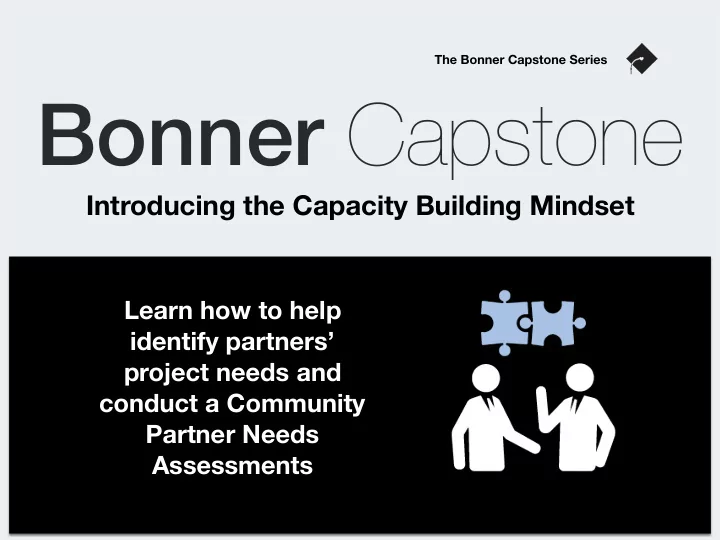

The Bonner Capstone Series Bonner Capstone Introducing the Capacity Building Mindset Learn how to help identify partners’ project needs and conduct a Community Partner Needs Assessments
Workshop Goals The purpose of this workshop is for students (especially sophomores) as they navigate their work with Bonner Partners to… 1 2 to practice and to understand the apply skills needed framework of to assess needs at capacity building community partners to take away a plan to approach community partners regarding capstone ideas 3
Today’s Agenda 1 2 3 SCENARIOS SCENARIOS REFLECTION REFLECTION INTRODUCTION • Goals and agenda • Problem solve • Review capstone • Reflection activity hypothetical process scenarios • Brave Space rules 6 5 4 INTRO TO CAPACITY 6 5 PRACTICE CONCLUSION NEEDS ASSESSMENT CONCLUSION BUILDING • Use a guided • Be introduced to the worksheet to come up • Make a plan for next concept of and be with your own inspired by examples steps questions for of capacity building community partners
“ Signature Work ” : A culminating educational activity in which students integrate and apply their learning to a significant project with meaning to the student and society
Bonner Capstone: A project that A project A signature connects your created with the experience community identity, service , and academics
Community Though capstones integrate these three elements, today we focus on the community component of capacity building projects.
What is capacity building? According to the Corporation for National Community Service (CNCS) and National Council of Nonprofits, capacity building is “an investment in the e ff ectiveness and future sustainability of a nonprofit.”
Why Capacity Building? Our partners need a strong infrastructure to fully and e ffi ciently serve the community We can provide partners with campus resources – including academic knowledge and our time – to enhance partners’ capacity to meet their missions and deliver strong programs
There are five categories of capacity building… Program Development and Training • Create new or revamp old programs • Design and facilitate curriculum Communications Research • Conduct community based or • Market or advertise events or public policy research services Capacity • Evaluate programs • Manage social media and other • Develop and implement building outreach efforts surveys • Develop branding Volunteer Recruitment and Fundraising Management • Research and write grants • Recruit and supervise volunteers • Raise funds creatively • Create a volunteer structure • Write proposals • Design and implement trainings
Nostrud Suscipit
And two other kinds of projects that might fall outside these categories… Disciplinary Projects Social Action Campaigns These team-based These projects are projects take a typically creative current political ways to address issue—local, needs in the national, or community. For international—and instance, they launch a campaign might involve arts. to address it.
Examples of Projects Category of Projects Common Products for the Especially Good Fit for Category of Projects Common Products for Especially Good Fit for Partner These Disciplines the Partner These Disciplines (Majors or Minors) or (Majors or Minors) or Types of Courses Types of Courses • Volunteer Volunteer Training Leadership • Research Applied Research Often great for the Social Management (also Volunteer Handbook Education Action Research Sciences: called Service Volunteer Retention Business Community-Based Public Policy Leadership) Analysis Civic Engagement Research Political Science Human Resources Strategy Public Policy Research Sociology Program Evaluation Psychology Oral Histories Anthropology • Program (and Curriculum Development Any major might apply Needs Assessment Social Work Organizational) Program Development disciplinary concepts (i.e., Qualitative Study (for Biology Development Program Replication STEM Fields community defined need) Business Plan Math Quantitative Study (for Education community defined need) Business • Communications Website Communications/PR • Creative/ Theater Production Drama and Technology Social Media Marketing Disciplinary Arts Production Arts Computer Program Computer Science Projects Journalism Project Humanities Marketing Plan Methods courses Community Forum Journalism • Fundraising Grant Research English Food Justice Grant Writing Nonprofit Management Communication Studies Earned Income Strategy Business Social Entrepreneurism • Social Action Campaign Sociology Policy Recommendation Political Science Public Policy Social Justice
Capacity Building Scenarios Practice Round I am a sophomore Bonner. I just switched my major to public health and my service site to a local clinic. I’m new to the academic content of my newfound passions and the community that I’m serving at my site. I am thinking about working with the clinic and forging a role in capacity building and, eventually, a capstone that addresses one of its needs while also meshing with my academic coursework and learning. What can I do to learn more about the work of the clinic and to identify various projects that I could work on that are needed?
Capacity Building Scenarios Instructions 1) Read your scenario and complete your worksheet (10 minutes) 2) Group up into your scenarios and discuss the best possible solution (10 minutes) 3) Discuss each scenario and each solution with new groups (10 minutes) Consider: • Your community • Your resources • Your skills/academics/interests • Barriers
Reflection • What did you learn from the activity —either about the scenario itself or how you or other students may approach similar situations at your site? • Why did we do this activity? • How might you apply what you learned moving forward?
Needs Assessment Remembering the practice scenarios and your knowledge of capacity building projects, complete the needs assessment brainstorm worksheet
Conclusion Capacity Building in Our Community Takeaways: • Practiced the skills to problem solve possible capacity building barriers • Learned about capacity building and how it applies to Bonner and partners • Began to brainstorm capacity building projects for your own service site • Set a tentative date to discuss site needs and your ideas with your site supervisor or community members using the Organizational Capacity Building Opportunities worksheet
Recommend
More recommend